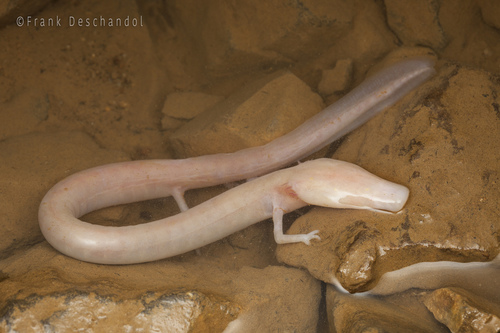
Olm
Proteus anguinus, or the olm, thrives in the shadowy waters of European caves. With ghostly skin and external gills, this blind salamander senses its world through smell and vibration, embodying the mysteries of subterranean life. Its unique adaptations make it a fascinating subject of ecological and evolutionary study.
15.0 - 20.0 g
Weight
Length: 20 - 30 cm
Size
Black, White, Pink
Color
14 years
Age of Sexual Maturity
5 mph
Top Speed
Vulnerable
Conservation Status
Decreasing
Population Trend
Characteristics
Proteus anguinus, commonly known as the olm or the 'human fish', is an aquatic salamander found in the limestone caves of the Dinaric Alps in Central and Southeastern Europe. It is known for its elongated, serpentine body, white skin, reduced eyes, and external gills. The olm is blind and relies on other senses to navigate its dark cave environment.
Distribution Range of the Olm
Proteus anguinus, commonly known as the olm, is native to the Dinaric Alps region of Southeastern Europe. This includes parts of Slovenia, Croatia, Bosnia and Herzegovina, and potentially extending into Montenegro and Serbia. The species is predominantly found in the karst areas characterized by limestone geology, which provides the necessary cave systems for its habitat.
Olm's Habitat
Environmental Conditions
The olm inhabits underwater cave systems that are part of the karst topography. These environments are typically characterized by low light conditions, stable temperatures ranging from 5°C to 15°C, and high humidity. The water within these caves is often oligotrophic, meaning it has low nutrient levels, and it is clear with a stable pH balance.
Ecological Niche
As a cave-dwelling amphibian, the olm has adapted to a life with limited food resources and no light. It plays a role in the cave ecosystem as both a predator and prey, feeding on small crustaceans, insects, and snails. The olm is highly adapted to its niche, exhibiting features such as regressed eyes, loss of pigmentation, and an elongated body to navigate its aquatic environment. It is a vital part of the subterranean food web and contributes to the ecological balance of its karst habitat.
Copyright @ Nature Style Limited. All Rights Reserved.
 English
English